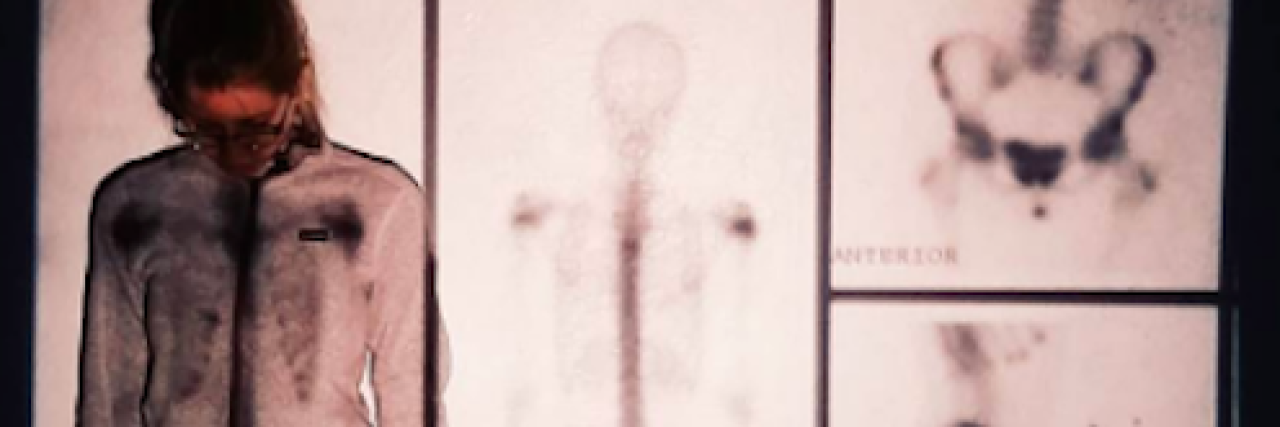The Battle of Living With a Rare Autoimmune Disease
My rheumatologist tells me, “To be honest, I don’t really know how to treat it, but I’ve seen it before.” This isn’t usually the statement you want to hear from your doctor, but I’m surprised and excited that my rheumatologist has even seen a case like mine. He’s talking about chronic recurrent multifocal osteomyelitis(CRMO) — a rare auto-inflammatory disease I was diagnosed with when I was 13. By rare, I mean it affects one in a million people, as far as we know.
There are two CRMO specialists in the United States (of which I’m aware), and all are outside my home state of California. Because it’s so rare, many doctors overlook it or misdiagnose their patients. I was caught between osteosarcoma, (aka bone cancer) and CRMO. My bone scan lit up with inflammation all over my body.
My illness often mimics the symptoms of other diseases and looks a lot like cancer on bone scans and X-rays. A bone biopsy has to be performed in order to rule out cancer, so my parents nervously waited outside as a surgeon used a giant needle to take a small sample of bone. Surgery was a blur. When I woke up, I asked for instant ramen. I was drugged up and hungry as hell.
Results came in and while my family and I were relieved I didn’t have cancer, we weren’t really sure what to do next. Before CRMO symptoms began, I was an active, normal kid who loved soccer, drumming, and riding horses. And bam, one day I’m bedridden, bawling at night because my back muscles are contracting from so much bone pain.
CRMO has “multifocal” in its name because it usually affects multiple parts of the body, and I had lesions in my left tibia, right shoulder, and t6 vertebrae. This was a serious blow to someone who played competitive soccer, rode horses every week, and thrashed around as a metal-core drummer.
So, I began a new battle.
Armed with a team of pediatric rheumatologists, I started breezing through medications. I’m happy to say we figured out a treatment plan after trying pills, injections, acupuncture, meditation, and what felt like a billion other options. I’m now on two medications that suppress my immune system, one I inject weekly and another I get infusions of every six weeks. Remicade and methotrexate pose risks to my health because they make me more susceptible to infection, but it’s worth it not to have excruciating bone pain. CRMO pain comes in “flare-ups,” which is a term we use to describe the inflammation that radiates in my bone out to surrounding muscles. The “flares” come and go, and can last from hours to weeks. My immune system is so overzealous that it actually damages my bones, creating holes and rough “moth-eaten” lesions.
Today, I am optimistic. I’m fortunate to have started working with the leading doctors in the US who are researching CRMO. I’ve made illustrations for them to use in brochures and joined a monthly conference call where we talk about research, data collection, and other topics related to the illness. I was recently invited to represent CRMO at the annual CARRA (Childhood Arthritis and Rheumatology Research Alliance) Conference and I’m so honored to be in a position to advocate for better care for patients with this rare illness.
This is one of the first steps in a long journey to improve treatment for children and adults with CRMO, and to maybe, one day, find a cure. I’m able to play drums and ride horses again, but soccer is still off limits due to the negative impact on my left knee. I’m OK with this.
Over time I’ve learned how to cope with chronic illness, and have met so many incredibly strong people who, in spite of the intense pain they’ve experienced, constantly aspire to help others.
What keeps us strong are the doctors who continue to research rare diseases, even with limited resources. We stay strong because we have amazing support systems of friends and family. We are strong because we form online communities and discuss ways to tell our doctors how to treat our illnesses, knowing they might not even know the name.
We know how to recognize our limitations. We know that our bodies sometimes need rest when we’d rather be going out with friends. We learn from our mistakes, and adjust to meet CRMO head-on.
We win, we lose, but we never stop trying.
We also understand that illness doesn’t define us — we define ourselves.

